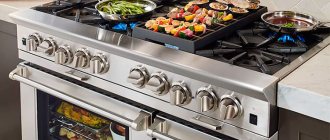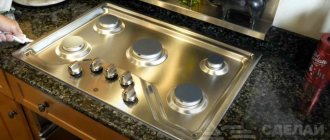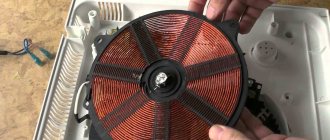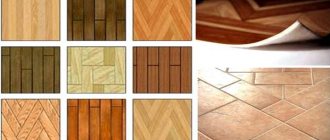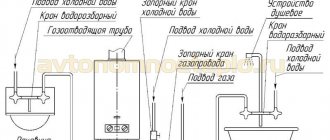When it comes to buying a new breadwinner, many users find it difficult to resolve such a pressing question: which is better - a gas stove or a hob. Manufacturers of household equipment offer excellent options for modern models of free-standing stoves, as well as a huge range of built-in hobs that run on blue fuel or from the electrical network.
According to experts, there is no definite answer - each consumer chooses an option that is acceptable to him. To find out the advantages and disadvantages, main technical indicators and the opinions of real users, just read this article carefully.
Surface Features
All users know the individual features of gas and electric stoves from operating experience, so let’s not waste time, but pay attention to the panels.
Familiar appearance
The best representatives of gas surfaces have burners with two or even three rows of perforations, which significantly increases the heating time of the dishes. The kit necessarily includes an economy nozzle, sometimes equipped with a device that hides open fire for uniform heating of the bottom of the cookware.
The gas hob is made of glass ceramics, which guarantees a rather stylish appearance; according to users, it is very convenient to cook on such splendor, and cleaning is not difficult. The burners are protected by durable original grates made of cast iron or steel coated with heat-resistant enamel.
New technologies
Glass ceramics have firmly entered the everyday life of Russian users; it has a number of advantages over enameled surfaces, but is afraid of mechanical stress: it is easily scratched even by sugar or salt crystals, not to mention pinpoint impacts that can split it. As for a simple electric stove, it only heats up in the area where the burners are installed, while an induction panel has no surface heating at all.
Such hobs are already being replaced by mirror glass panels, which have similar advantages, but cost much less, decorate the kitchen interior many times better and are not afraid of mechanical impact from falling small objects. A lot can be said about the advantages of conventional gas and glass-ceramic built-in panels; they perform well in operation and have individual advantages, but the main thing is safety. For new surfaces it is much higher than for gas stoves.
MATERIALS OF MANUFACTURE
When understanding what is better - a gas stove or a panel, one cannot ignore the materials used by manufacturers to produce devices of these two types. Traditional stoves are usually created from stainless steel or metal with an enamel coating. Hobs are exactly the same, but they have one advantage - the use of glass ceramics. Models made using the gas-on-glass technology look more elegant and fit better into the interior than bulky stoves. They are also equipped with stable grilles that protect the glass ceramics from possible damage.
Specifications
Users have long known all the tactical and technical data of gas stoves, but only a few of them are familiar with modern hobs.
Heating type
There are three options:
- Natural gas, mainline or liquefied.
- From the electrical network.
- Combined: gas + electric burners, gas + induction.
There are a lot of options for combining: two different burners, three - gas, one - cast-iron electric, or vice versa, it all depends on the preferences of the consumer.
Control
Independent built-in panels are equipped with an individual panel, while dependent options are equipped with an oven, since they are always installed above it.
Surface type
There are several options here:
- Enameled plates are a classic coating of heat-resistant enamel of different colors, mainly for free-standing gas and electric models.
- Stainless steel - used in many models, matches any interior, is not afraid of mechanical stress, and is easy to clean.
- Glass ceramic is a great design, but is susceptible to pinpoint impacts and scratches.
- Mirror glass is highly durable and can be of different color shades, but during long-term use small scratches appear that negatively affect the appearance.
Which coating to choose and what will behave better is a rhetorical question, it all depends on the accuracy of the user.
Burners
The size and quantity can be selected according to your needs - from 2 to 7 pieces, their arrangement can be standard - these are models for 2, 3 and 4 burners or varied for 5 or more: one separately, and the others in a square; the large one is in the center, and the medium and small ones around or all in two rows.
Lattices
During operation, steel and cast iron behave almost identically, unless the former are made in China, where they like to save money, so they use rather thin rods that cannot withstand large volumes of dishes. The second option has a lot of weight; if there is only one grate, housewives cannot remove it for washing, so manufacturers divide them into two and sometimes three parts.
Functions
Gas panels are equipped with automatic ignition, so you no longer need matches; there is gas control. Electric surfaces have their own individual control features, which are indicated in the instructions. Additionally, developers install various options, many of which are never used in everyday life.
Important! Before choosing a hob, pay attention to small details and bonuses - they are rarely used, but they affect the final cost.
Each stove or built-in hob has unique features that must be taken into account when purchasing.
Electric stoves
Classic electric stoves with burners in the form of cast iron “pancakes” are gradually becoming a thing of the past. They have been replaced by modern models with glass-ceramic surfaces.
If gas stoves have improved more externally, then electric stoves have changed radically. Completely different designs of stoves and even electric stoves with new operating principles appeared.
The most progressive among them are induction models. These are multifunctional electrical appliances that not only allow you to cook quickly and comfortably, but can also decorate the interior of your kitchen with their beautiful appearance. Instead of the protruding burners of outdated models, there is now a perfectly smooth mirror glass surface.
There are also many pleasant and useful options in controlling the device.
Advantages and disadvantages
Any technique has positive and negative qualities - this is an axiom. Gas products are still in high demand due to the price, which is the lowest on the household appliances market, and also because blue fuel is cheaper than electrical energy. Installation and connection are carried out by specialists in similar equipment.
The disadvantages are that it is necessary to ensure the laying of a gas pipeline, there is an increased risk of fire, since an open fire is used, and the fuel itself is explosive. The difference between a standard stove and a panel is very significant: the first does not sit well next to furniture, because the body gets very hot, and there are gaps between the stove and cabinet furniture where dust and small debris accumulate.
Electrical surfaces made of glass ceramics have the following positive qualities:
- Aesthetics of appearance.
- The contours of the heating zone are marked on the surface.
- No clunky grilles or rotary switches.
- They are simple and easy to use and have small dimensions.
- The induction version has increased comfort, high efficiency and safety.
Among the disadvantages:
- the cost is much more expensive, this is especially true for induction panels;
- the working surface is quite capricious: as soon as a grain of sugar lands on the heated part of the stove, a small crack immediately appears; maintenance requires special detergents;
- user inattention can lead to chipping and breakage of such a surface;
- Repairs are very expensive, especially replacement after even a small area is broken.
The difference in coverage is huge, each has its own nuances, as well as flaws, so you need to weigh the pros and cons so that the chosen model does not disappoint you during operation.
Care
Both devices are resistant to abrasive materials (powders and soda), steel wool, hard sponge surfaces and concentrated acids. The electrical panel is afraid of burnt food particles and liquids containing sugar: they leave marks and damage the protective layer. Induction cookers do not heat up, so they are easier to clean from dropped food and spills with a soft, damp sponge.
It is important to protect glass-ceramic hobs from impacts from heavy and hard objects. If a crack has formed on the surface, it is prohibited to use it.
The nuances of an independent oven
Many users are still not aware of the difference between an oven and an ordinary oven installed in a standard stove. The main differences between electric and gas ovens are known to everyone: the former are much more powerful, and their baked goods turn out more appetizing, with a fragrant golden brown crust. They are not very different in size: the same standard is 600x600 mm, but models are available with a width in the range of 700-900 mm, however, their cost is high.
They are installed independently, i.e. it is not necessary to build them under the countertop. Many users place them separately and above the table for convenient use, and bright lighting helps to monitor the cooking process. An autonomous cabinet is available in gas or electric, but the former has a smaller range, because it is in little demand: making a separate connection is unprofitable for many buyers.
The electric option has a number of advantages:
- location at eye level;
- ease of connection;
- delay start timer;
- several modes;
- Some models have a microwave mode - you can save money and space in the kitchen by purchasing two in one.
The disadvantages are similar to all the negative qualities that are inherent in electrical equipment.
WHICH DEVICES TO GIVE PREFERENCE
So, taking into account the considered pros and cons of gas stoves and gas panels, we can conclude that both deserve the attention of modern housewives. If you don’t want to experience installation difficulties, allocate a large sum for purchase and get used to the dual control system, you should choose a regular stove. In addition, this option is more convenient for older people who are accustomed to rotary switches and standard forms. In other cases, we recommend taking a closer look at the hobs. They take up less space in the kitchen, look more beautiful and fit perfectly with any interior. And in terms of cooking (if you don’t take into account the oven), they are no different from conventional stoves.
If you liked our article, please like it, we will be pleased. You can also subscribe to our channel and find out useful information.
conclusions
You are better off buying a freestanding stove if:
- the ability to rearrange and trouble-free replacement of the device is important;
- don’t want to waste time and money on installation;
- you’re used to using a regular stove and don’t want to change your habits;
- looking for a budget option.
It is better for you to buy a built-in stove if:
- create an individual interior solution with a non-standard layout;
- want to save space;
- stylish kitchen interior design is extremely important to you;
- want to raise the oven higher for convenient and safe use;
- Are you planning to make custom-made furniture?
- are willing to spend more to get the custom kitchen of their dreams.
How an induction cooker works: characteristics and distinctive features of the panel
What an induction cooker means will become clear when you study the principle of its operation. It is based on the phenomenon of electromagnetic induction. At the moment a high-frequency current flows through an induction coil with a winding made of a copper conductor, its transformation occurs with the formation of an alternating electromagnetic field. When a cookware that has ferromagnetic properties is placed on the work area, the resulting physical phenomenon promotes the movement of electrons located on the bottom surface of the product.
Thus, the process of heat release occurs, which is spent exclusively on heating the dishes. In this case, the surface of the stove remains cold. Thanks to its unique operating principle, the induction hob has a number of advantages:
- low costs of electricity, which is spent exclusively on creating an electromagnetic field in the closed conductor of the induction coil;
- maximum efficiency, increasing the efficiency of the device, as a result of which a minimum amount of time is spent on cooking;
- a high level of safety, which is ensured by the feature of the stove that it begins to work the moment the dishes are placed on it and completes the process when there is no element on the burner;
- the ability of the stove surface to remain cold, which simultaneously contributes to low energy costs and eliminates the possibility of burns;
- the ability to set the required heating temperature with an accuracy of 1 degree;
- automatic selection of settings that allow you to recognize the diameter of the dishes;
- equipped with a large number of functions and programs;
- easy and simple care that does not require the use of special products.
During operation of the induction cooker, only the cookware heats up, and the panel itself remains cold
The disadvantages of the product include the following characteristics:
- the occurrence of specific noise during operation of the surface, which is associated with the operation of fans cooling the coils;
- high surface cost compared to other types of panels;
- for an induction cooker you must use special cookware;
- This device negatively affects the operation of other household appliances that are located very close to the surface of the device.
Important! When cooking on an induction hob, remove all jewelry and watches. The former, when heated, can burn the skin, the latter - become magnetized.
